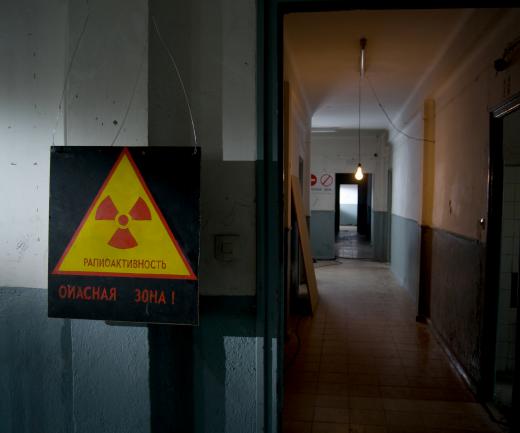What is a Geiger Counter?
 Mary McMahon
Mary McMahon
A Geiger counter is a scientific device used to measure ionizing radiation, radiation which has created electrically unstable atoms. Because of the extreme sensitivity of a Geiger counter, it is ideal for measuring even very low levels of radiation. There are a number of uses for Geiger counters and other radiation detectors including physics, astronomy, and the medical industry. Specially designed versions can also be targeted to read specific types of radiation.
The initial groundwork for the Geiger counter was laid in 1908, when a German physicist named Hans Geiger developed an early version of the device. In 1928, with the help of Walther Muller, Geiger refined his counter, making it more effective and sensitive. Other scientists have added to the technology since then, although the basic principles of how a Geiger counter operates remain the same.

The core of a Geiger counter is a Geiger tube, a glass cylinder filled with a gas such as helium, neon, or argon. A thin metal wire runs down the middle of the tube, charged with voltage which varies, depending on the application, but is usually around 1,000 volts. When ionized particles come into contact with the gas in the tube, they collide with the gas and produce an electron. The electron is drawn towards the charged wire in the middle of the tube, colliding with more atoms and ionizing them along the way, and creating a charge on the wire. This charge can be translated into a measure of how much radiation is active in the area.
The classic clicking noises associated with a Geiger counter are one way to indicate active radiation. Each click indicates a separate electrical charge caused by radiation. Most Geiger counters also use a dial to show how much radiation is present. The Geiger counter is highly sensitive because the gas loses its charge quickly after each collision, allowing a scientist to get a precise measurement of how much radiation is active in the area being covered by the Geiger counter.
While many people associate the Geiger counter with nuclear physics and the military, there are a number of other useful applications for the device. Astronomers use Geiger counters to measure low level cosmic rays which can provide insight into the creation of the universe, for example, and geologists locate radioactive minerals with the assistance of Geiger counters. They are also very useful in nuclear medicine, to follow radioactive tracers and identify malignancies.
AS FEATURED ON:
AS FEATURED ON:











Discussion Comments
if it clicks to the point where all you hear is a continuous beep, run.
I've just purchased a geiger counter and would like to know more on the radiation levels i.e. what are the safe and dangerous levels? I am a complete beginner. So if anyone could send me some sort of list, I'd be very grateful.
Post your comments